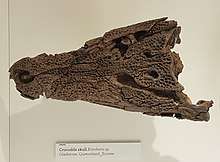Kambara
Kambara is an extinct genus of mekosuchine crocodylian that lived during the Eocene and Oligocene epochs in Australia.
| Kambara | |
|---|---|
 | |
| Skull of Kambara sp. at the Melbourne Museum | |
| Scientific classification | |
| Kingdom: | Animalia |
| Phylum: | Chordata |
| Class: | Reptilia |
| Order: | Crocodilia |
| Family: | Crocodylidae |
| Subfamily: | †Mekosuchinae |
| Genus: | †Kambara Willis et al., 1993 |
| Species | |
| |
Description
At around 55 million years old, remains of Kambara are among the oldest Tertiary fossils found in Australia (although there are some recent Cretaceous fossils that are twice that age). Kambara is the oldest known mekosuchine. The genus name comes from an Aboriginal term meaning "crocodile".
There are currently four species of Kambara described: the type species K. murgonensis (Willis & Molnar, 1993), K. implexidens (Salisbury & Willis, 1996), K. molnari (Holt et al., 2005), and K. taraina (Buchanan, 2009). All four species have a generalised crocodylian body plan, growing to sizes similar to the modern Saltwater Crocodile, Crocodylus porosus. Kambara shows an interesting characteristic of having multiple bite patterns within the same genus. Kambara murgonensis has a near complete overbite, K. implexidens a more interlocking dentition and K. molnarai an intermediate condition. While initially thought to be the most primitive member of an Australasian radiation of mekosuchine crocodylians, recent studies (Holt, et al., 2007) have suggested that this may not be the case, and that there are at least two separate lineages in Australia.
Kambara and other mekosuchines are often thought to have been better adapted to movement on land than are living crocodilians. The degree of twisting or torsion in the humerus of Kambara is less than that of living crocodilians, and the shoulder joint of Kambara is stronger and allows for greater motion than those of modern species. However, Kambara is still thought to have been at least partially aquatic because its head is flattened like that of typical aquatic crocodilians.[1]
Fossils have been found at the Murgon fossil site in south-eastern Queensland.
References
- Stein, M.; Salisbury, S. W.; Hand, S. J.; Archer, M.; Godthelp, H. (2012). "Humeral morphology of the early Eocene mekosuchine crocodylianKambarafrom the Tingamarra Local Fauna southeastern Queensland, Australia". Alcheringa: An Australasian Journal of Palaeontology: 1. doi:10.1080/03115518.2012.671697.
- Buchanan, L.A. 2009. "Kambara taraina sp. nov. (Crocodylia, Crocodyloidea), a new Eocene mekosuchine from Queensland, Australia, and a revision of the genus". Journal of Vertebrate Paleontology 29 (2): 473–486.
- Holt, T. R., S. W. Salisbury, and P. M. A. Willis. 2005. A new species of mekosuchine crocodilian from the middle Palaeogene Rundle Formation, central Queensland. Memoirs of the Queensland Museum 50: 207–218.
- Holt, T. R., S. W. Salisbury, T. H. Worthy, C. Sand and A. Anderson. 2007. New material of Mekosuchus inexpectatus (Crocodylia: Mekosuchinae) from the Quaternary of New Caledonia. CAVEPS 2007, Melbourne Australia.
- Salisbury, S. W., and P. M. A. Willis. 1996. A new crocodylian from the early Eocene of south-eastern Queensland and a preliminary investigation of the phylogenetic relationships of crocodyloids. Alcheringa 20: 179–226.
- Willis, P. M. A., R. E. Molnar, and J. D. Scanlon. 1993. An early Eocene crocodilian from Murgon, southeastern Queensland. Kaupia 3: 27–33.
External links
- "ANIMAL SPECIES: Kambara implexidens". Archived from the original on 2011-11-28. Retrieved 2019-01-29.